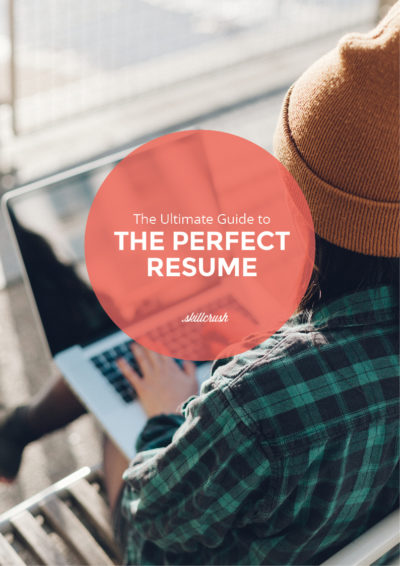
Get Our FREE Guide to the Perfect Resume
Learn how to write resumes that get you HIRED with our FREE, 30+ page ebook.
Just like waiting in a crowded DMV, job hunting isn’t exactly a fun way to spend your time. But unlike at the DMV, you won’t have your in-person charm to win over an employer when you first send in that application. That’s where your resume comes in. (Who even reads cover letters these days?) While the content should be airtight, clearly-written, and typo-free, the look of your resume will go a long way towards getting you noticed.
Surely you’ve seen the trend of the infographic resume over the past few years, but if you’re a coder without much of a design background, making one for yourself probably seems out of reach. However, if you’re a senior-level designer or a paint-by-numbers amateur, you can still have a resume that’s professional and eye-catching. Here’s how.
If you have zero design skills whatsoever, go the infographic resume template route.
Piktochart has plenty of easy-to-navigate templates that are as swoon-worthy as they are polished—without any grunt work necessary. Best of all, many of the templates are free. If you need guidance about choosing a template, start with some research on the job and company itself (this is good advice for anyone navigating the application process).
When you’re doing your homework on the company, get a handle on their culture: Are they creative and relaxed—the kind who’d appreciate you flexing your imaginative skills? Or maybe they lean toward traditional or even formal, in which case you’ll want to pick something simple and minimal to stand out without being a culture clash.
Now take a big picture approach. How do you want to represent your personality, style, and accomplishments? If you don’t have any solid ideas, or if you just need to further cement the logistics of your layout and design, browse other infographic resumes that are designed for similar job roles for inspiration.
If you want to try your hand at design yourself, stick to the basics.
In order to ensure that your resume is organized and easy to read, keep the direction of text consistent—whether across or down—rather than all over. Give your design a hierarchy so people can easily figure out the organization by breaking up big chunks of text into headings in bigger fonts, with subheadings and information in smaller fonts. Make sure those smaller fonts are readable—no curlicues or novelties. Avoid busy patterns or cluttered graphics, and stick with two to three colors max.
And speaking of color, there’s much more to it than we might think—so much so that so that huge companies stake their success on it. It’s why we associate dependable and down-to-earth brands like Animal Planet, Whole Foods, and the Girl Scouts with the color green and adventurous trademarks like Netflix and Coca Cola with red. So think about how you want to present yourself to the world—and to the recruiters who’ll be judging you on this—and choose your colors accordingly. Does your job require a sense of boldness? Choose a shade of crimson or coral. Are you vying for a graphic designer dream job? Stick with shades of purple to showcase your creativity and imagination. When in doubt, stick with subtle shades of blues and greens, which are calming and trustworthy.
Set up a strategy.
Your resume should do more than just look attractive—it absolutely must showcase your talent and work history in a way that best reflects the position you’re after. Do you need to prove that you’re wildly adept at organization and can churn out a mean organizational chart? Make sure your resume reflects that.
You’ll need to utilize the most logical methods of data visualization—which is where people often get tripped up in this process. Don’t use a Venn diagram (intended for qualitative results) to represent your previous experience simply because you like the aesthetic look of overlapping circles. A timeline is the cleanest and most efficient way to distill a lengthy work history (as well as “dates, promotion, milestones,“) into a single, legible graphic. Focus on the results you’ve achieved, rather than standard responsibilities, as often as possible. Use a line graph to represent your upward ascension at your previous workplace, either for years, number of awards or completed projects, or even client satisfaction.
Tell your own story.
Time for some real talk. You’re applying for a position in a competitive market, so every job is highly coveted—and that means you’re most likely up against a flood of rival applicants. But this is precisely the reason why you should inject yours with as much “you-ness” as possible. Yes, you need to list your strengths, skills, and employment history, but you also want a potential employer to know who you are as an individual—something that will benefit you both. Including a casual yet professional photo of yourself is the easy way to introduce yourself as more than just a name on a page. Make sure to include as many of your social media accounts or personal websites as possible, if necessary. You might also consider asking a former boss or client for a quote about you that you can include, for a more intimate opinion about why you’re the best candidate for the job. If that’s the final thing a recruiter sees on a resume that’s also cleverly and creatively designed, chances are they’ll agree!
Lauren Pezzullo currently resides in Austin, TX where she writes about workplace culture and human resource solutions for Pingboard. Pingboard is real-time, collaborative org chart software that makes it easy to organize teams, plan for growth, and keep everyone informed.

Get Our FREE Guide to the Perfect Resume
Learn how to write resumes that get you HIRED with our FREE, 30+ page ebook.

